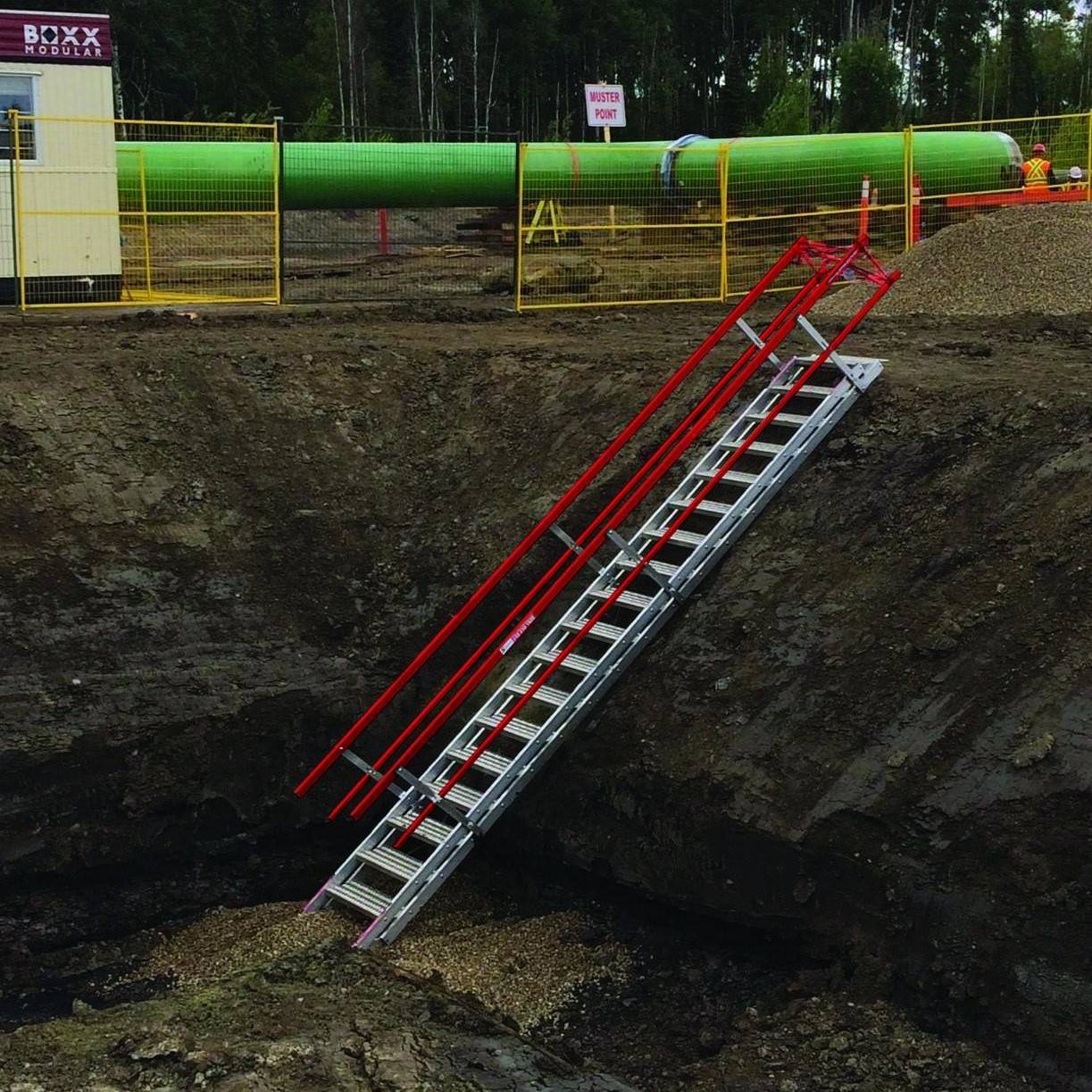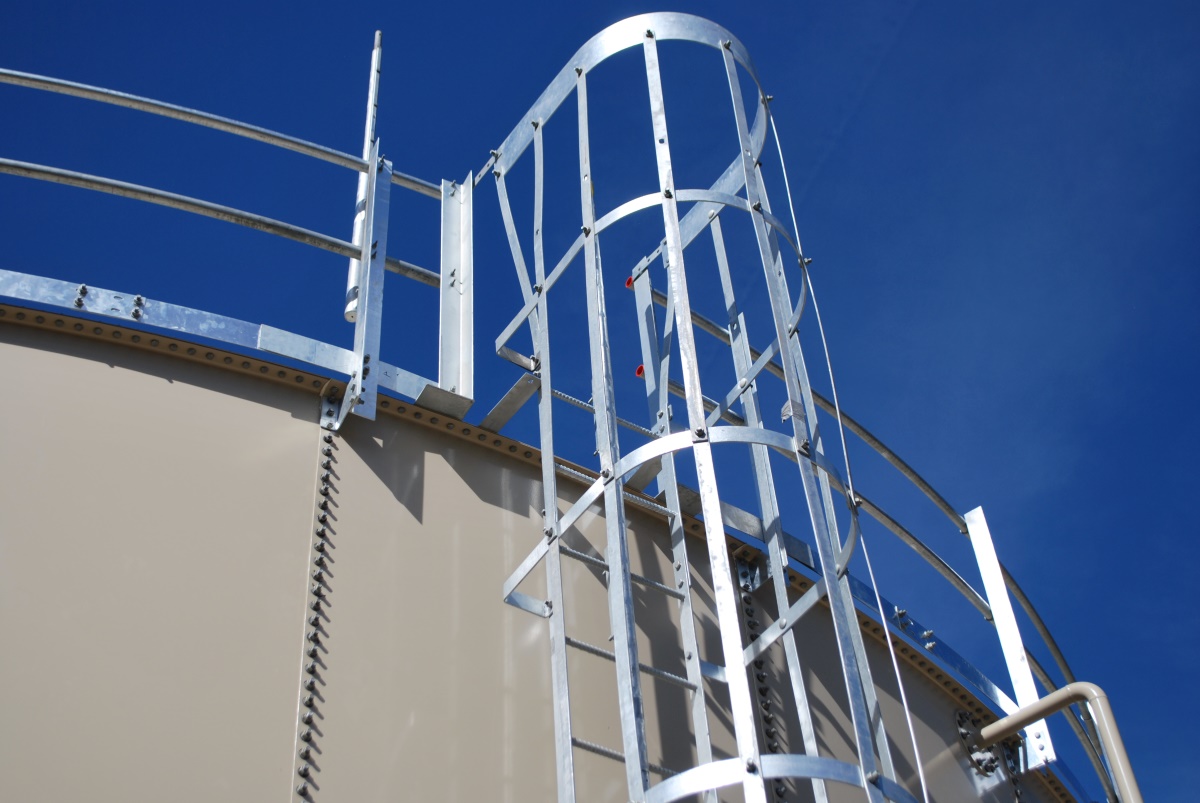Home>Articles>When Is A Stairway Ladder Or Ramp Necessary In An Excavation


Articles
When Is A Stairway Ladder Or Ramp Necessary In An Excavation
Modified: May 6, 2024
Find out when a stairway ladder or ramp must be present in excavations in these situations. Read more in our informative articles.
(Many of the links in this article redirect to a specific reviewed product. Your purchase of these products through affiliate links helps to generate commission for Storables.com, at no extra cost. Learn more)
Introduction
Excavations are a common occurrence in various industries, such as construction, mining, and infrastructure development. They involve the process of digging or removal of earth, soil, or rock to create space or access to underlying structures. While excavations are necessary for numerous purposes, they also pose significant risks to worker safety if not properly managed.
Safety measures play a crucial role in preventing accidents and injuries in excavations. One essential requirement in ensuring safety is the provision of a stairway, ladder, or ramp. These structures not only enable safe entry and exit from the excavation but also facilitate efficient movement and work within the confined space.
In this article, we will explore the situations in which a stairway, ladder, or ramp must be present in excavations. It is important to note that these requirements are in accordance with safety regulations to minimize the risk of accidents and ensure the well-being of workers.
By understanding and complying with these specifications, employers can create a safer working environment and mitigate potential hazards associated with excavations. Let’s delve deeper into the specific situations that necessitate the presence of a stairway, ladder, or ramp in excavations.
Key Takeaways:
- Excavations require a stairway, ladder, or ramp for safe access and egress, especially in deep, long-term, or frequently accessed sites. Compliance with safety regulations is crucial to prioritize worker safety and prevent accidents.
- The presence of heavy equipment, underground utilities, or hazardous materials in excavations necessitates designated access structures to minimize risks and ensure compliance. Prioritizing safety and adhering to regulations enhances worker well-being and business reputation.
Read more: When Is A Ladder Required In An Excavation
Definition of Excavations
Excavations, in the context of construction and infrastructure development, refer to the process of digging, trenching, or otherwise removing earth, soil, or rock to create space or access to underlying structures. These structures can vary in size and depth, depending on the purpose of the excavation, and may be temporary or permanent.
Excavations are a pivotal part of various industries, including construction, mining, and utilities. They are carried out to construct foundations for buildings, install underground pipelines and utilities, create underground structures such as tunnels, and perform archaeological research.
Excavations involve significant manual labor, the use of heavy machinery, and the exposure to potentially hazardous environments. Therefore, it is essential to prioritize safety and implement precautionary measures to mitigate the risks associated with excavations.
Safety regulations, such as those developed by the Occupational Safety and Health Administration (OSHA) in the United States, provide guidelines and requirements to ensure the safety of workers involved in excavation activities. These regulations outline the necessary precautions and equipment needed to prevent accidents, injuries, and fatalities in excavation sites.
One such critical requirement is the provision of a stairway, ladder, or ramp in excavations. These structures serve as means of access and egress from the excavation site, allowing workers to enter and exit safely. They also facilitate the movement of workers and equipment within the excavation, enhancing productivity and efficiency.
In the next sections, we will explore the importance of safety measures in excavations and delve into the specific situations that mandate the presence of a stairway, ladder, or ramp. Understanding and adhering to these requirements is crucial for ensuring the safety and well-being of workers in excavation sites.
Importance of Safety Measures
Safety is of paramount importance in any workplace, and excavations are no exception. Due to the inherent risks involved in digging and working in confined spaces, it is crucial to implement comprehensive safety measures to protect workers from potential hazards.
Here are some key reasons highlighting the importance of safety measures in excavations:
1. Preventing Accidents and Injuries: Excavations can be hazardous environments with risks of cave-ins, falls, equipment accidents, and exposure to harmful substances. Implementing safety measures such as providing protective equipment, training workers on proper procedures, and ensuring safe access and egress can significantly reduce the likelihood of accidents and injuries.
2. Ensuring Worker Well-being: Workers’ safety and well-being should always be a priority. By adhering to safety regulations, employers demonstrate their commitment to providing a safe working environment. This not only helps in preventing accidents but also boosts the morale and productivity of workers, creating a positive work culture.
3. Legal Compliance: Governments and regulatory bodies have established safety regulations and standards that employers must comply with. Failure to meet these requirements can result in legal consequences, including fines and penalties. Adhering to safety measures ensures legal compliance and helps protect businesses from unwanted legal issues.
4. Minimizing Financial Losses: Accidents and injuries in excavations can lead to significant financial losses for both workers and employers. Medical expenses, loss of productivity, legal fees, and potential lawsuits can severely impact the financial stability of individuals and organizations. By investing in comprehensive safety measures, these losses can be minimized or even avoided altogether.
5. Reputation and Client Confidence: Companies that prioritize safety measures in their excavation projects develop a reputation for being responsible and reliable. Clients are more inclined to work with contractors and organizations that demonstrate a commitment to worker safety. A positive reputation leads to increased client confidence and can ultimately contribute to business growth and success.
Safety measures are not just a legal requirement but also an ethical responsibility. Employers should strive to create a safe working environment in which workers can carry out their tasks without fear of harm or injury. By implementing robust safety measures, including the provision of a stairway, ladder, or ramp, employers can ensure the well-being of their workforce and mitigate potential risks in excavation sites.
Requirement of a Stairway, Ladder, or Ramp
In excavation sites, the presence of a stairway, ladder, or ramp is a fundamental requirement to ensure safe access and egress. These structures are essential for the movement of workers, equipment, and materials within the excavation, reducing the risk of accidents and improving overall efficiency.
Here are some key reasons highlighting the requirement of a stairway, ladder, or ramp in excavations:
1. Safe Entry and Exit: Excavations often involve working in confined spaces with vertical or steep sides. Without a proper means of access and egress, workers may risk falls, trips, or injuries. A stairway, ladder, or ramp provides a secure pathway for workers to enter and exit the excavation, minimizing the chances of accidents and ensuring their safety.
2. Facilitating Movement: Excavation sites are dynamic environments where workers need to move around to carry out their tasks effectively. A well-designed stairway, ladder, or ramp allows easy movement within the excavation, reducing the time and effort required to navigate through challenging terrain. This improved mobility enhances productivity and workflow efficiency.
3. Equipment and Material Handling: Excavations often involve the use of heavy machinery and equipment, as well as the transportation of materials. A stairway, ladder, or ramp provides a designated pathway for equipment and materials to be safely transported into and out of the excavation. This prevents damage to the equipment and minimizes the risks associated with manual handling.
4. Emergency Evacuation: In emergency situations such as sudden collapse, flooding, or hazardous material release, a stairway, ladder, or ramp is essential for quick and orderly evacuation of workers from the excavation site. These structures serve as vital escape routes, enabling workers to reach a safe location rapidly, ensuring their well-being in times of crisis.
5. Compliance with Safety Regulations: Safety regulations, such as those outlined by OSHA, specify the requirement of a stairway, ladder, or ramp in excavations that surpass a certain depth or duration. Adhering to these regulations is not optional but mandatory to ensure compliance and mitigate risks. Failure to provide these access structures can result in legal consequences and jeopardize the safety of workers.
6. Accessibility for Inspections and Repairs: Excavations often require periodic inspections and repairs to maintain structural integrity and safety. A stairway, ladder, or ramp provides convenient accessibility for inspectors and maintenance personnel to carry out necessary assessments and maintenance tasks, promoting long-term safety within the excavation.
By fulfilling the requirement of a stairway, ladder, or ramp in excavations, employers demonstrate their commitment to worker safety and ensure compliance with safety regulations. These structures enable safe entry and exit, facilitate efficient movement, and provide crucial pathways for equipment and emergency evacuation. Incorporating them into excavation site design and operations is essential for a safer and more productive work environment.
Situations Requiring a Stairway, Ladder, or Ramp in Excavations
The presence of a stairway, ladder, or ramp in excavations is necessary in various situations to ensure safe access and egress for workers, equipment, and materials. These structures provide a means of entry and exit, facilitate movement within the excavation, and ensure compliance with safety regulations. Let’s explore some specific situations that require the provision of a stairway, ladder, or ramp in excavations.
1. Depth of Excavation: As an excavation deepens, the risk of falls and injuries increases significantly. Safety regulations often specify that once an excavation reaches a certain depth, typically four feet or more, a means of safe access, such as a stairway, ladder, or ramp, must be provided. This requirement ensures that workers can enter and exit the excavation safely, reducing the chances of accidents and injuries.
2. Duration of the Excavation: Excavations that are intended to last for a prolonged period, such as long-term construction projects or mining operations, require the provision of permanent or semi-permanent access structures. This ensures consistent safe access throughout the duration of the excavation, allowing workers to enter and exit easily and minimizing the risks associated with accessing the site.
3. Frequency of Access: In situations where excavations require frequent access, such as maintenance or repair work, a stairway, ladder, or ramp must be present to facilitate efficient movement in and out of the excavation. This enables workers to access the site quickly without compromising their safety, reducing the time and effort required for each entry and exit.
4. Presence of Heavy Equipment: Excavations often involve the use of heavy machinery and equipment, such as excavators, cranes, and dump trucks. These equipment require designated pathways to move in and out of the excavation safely. Providing a stairway, ladder, or ramp allows for the proper transportation of heavy equipment, reducing the risks of accidents and collisions within the excavation.
5. Presence of Underground Utilities: Excavations in urban areas or construction projects that involve the installation or servicing of underground utilities, such as pipelines or cables, require safe access for workers to perform their tasks. A stairway, ladder, or ramp ensures that workers can enter the excavation site safely, work efficiently, and exit without endangering themselves or the utilities.
6. Presence of Hazardous Materials: Some excavations involve working with or around hazardous materials, such as toxic substances or chemicals. In these situations, a stairway, ladder, or ramp may be necessary to establish a safe and designated access route to prevent the contamination of workers or the environment. This ensures that workers can navigate the excavation without coming into direct contact with the hazardous materials or compromising their safety.
By recognizing and addressing these specific situations, employers and project managers can ensure compliance with safety regulations and provide a safe working environment for personnel involved in excavation activities. The provision of a stairway, ladder, or ramp in these situations promotes efficiency, minimizes risks, and prioritizes the safety and well-being of everyone involved in the excavation process.
Read more: How To Build A Ramp Over Stairs
Depth of Excavation
The depth of an excavation plays a crucial role in determining the need for a stairway, ladder, or ramp. As the excavation deepens, the risks associated with entering and exiting the site increase significantly. Therefore, safety regulations often stipulate that once an excavation reaches a certain depth, typically four feet or more, a means of safe access must be provided.
Here are some reasons why the depth of the excavation necessitates the presence of a stairway, ladder, or ramp:
1. Fall Prevention: Deep excavations pose a higher risk of falls, as workers need to navigate steeper slopes or vertical sides. Without a structured means of access and egress, workers may be at a greater risk of losing balance, slipping, or tripping, which can result in serious injuries. Providing a stairway, ladder, or ramp mitigates these risks by offering a stable and secure pathway for workers to enter and exit the excavation safely.
2. Increased Effort and Fatigue: Climbing up or down the sides of a deep excavation can be physically demanding and tiring for workers. This not only affects their productivity but also increases the likelihood of accidents due to fatigue. By installing a stairway, ladder, or ramp, workers can navigate the excavation with less physical strain, reducing fatigue levels and ensuring they remain alert and focused on their tasks.
3. Accommodating Equipment and Materials: Deep excavations often require the use of heavy machinery and the transportation of materials. Without a proper access structure, it becomes challenging to move equipment and materials in and out of the excavation safely. A stairway, ladder, or ramp provides a designated pathway for the movement of equipment, reducing the risk of equipment damage and minimizing the potential for accidents during transportation.
4. Emergency Situations: In the event of an emergency, such as a sudden collapse or the need for evacuation, deep excavations without adequate means of access can present a significant challenge. Workers may struggle to exit the excavation quickly and safely, putting their lives at risk. Having a stairway, ladder, or ramp in place ensures that workers can easily access escape routes in emergency situations, improving their chances of a swift and orderly evacuation.
It’s important to remember that the specific depth at which a stairway, ladder, or ramp is required may vary depending on local safety regulations or project specifications. However, the underlying principle remains consistent: as the depth of the excavation increases, the need for a structured means of access becomes more critical to prevent accidents, facilitate efficient movement, and ensure the safety of workers.
By adhering to the regulations and providing a suitable access structure based on the depth of the excavation, employers can prioritize worker safety and contribute to a safer working environment in excavation sites.
Duration of the Excavation
The duration of an excavation project is an important factor to consider when determining the need for a stairway, ladder, or ramp. Excavations that are intended to last for a prolonged period, such as long-term construction projects or mining operations, require the provision of permanent or semi-permanent access structures.
Here are some reasons why the duration of the excavation necessitates the presence of a stairway, ladder, or ramp:
1. Consistent Access: A long-term or ongoing excavation project requires a reliable means of access for workers, materials, and equipment throughout the duration of the project. Installing a permanent or semi-permanent stairway, ladder, or ramp ensures that workers have a consistent and safe pathway for entering and exiting the excavation site, eliminating the need for temporary structures that may compromise safety.
2. Efficiency and Productivity: Without proper access structures in place, workers may experience delays and challenges in accessing the excavation site, resulting in decreased productivity. A well-designed stairway, ladder, or ramp facilitates quick and efficient movement in and out of the excavation, allowing workers to focus on their tasks and complete them in a timely manner.
3. Safety Considerations: The longer an excavation project continues, the higher the potential risks become. Workers may become more familiar with the site, which can lead to complacency or a lack of focus on safety protocols. Having a dedicated access structure, such as a stairway, ladder, or ramp, reinforces the importance of safety and helps reduce the chances of accidents or injuries as the project progresses.
4. Compliance with Regulations: Depending on the duration of the excavation, local safety regulations may require the provision of a stairway, ladder, or ramp to ensure compliance. These regulations are put in place to protect the well-being of workers and ensure consistent safety standards throughout the duration of the project. By adhering to these regulations, employers demonstrate their commitment to worker safety and minimize the risk of non-compliance penalties.
5. Long-Term Cost-Effectiveness: Although the initial installation of a permanent or semi-permanent access structure may require an investment, it can prove to be more cost-effective in the long run. Temporary structures may incur frequent maintenance costs or the need for replacement, whereas a well-constructed stairway, ladder, or ramp can withstand the duration of the excavation project and provide continuous access without compromising safety.
By considering the duration of the excavation and implementing a suitable access structure, employers can ensure consistent and safe access for workers throughout the project. This not only promotes efficiency and productivity but also upholds compliance with safety regulations and the well-being of workers.
A stairway, ladder, or ramp must be present in excavations where employees are required to travel more than 4 feet vertically. This is to ensure safe access and egress for workers in the excavation.
Frequency of Access
The frequency of access to an excavation site is a significant factor influencing the need for a stairway, ladder, or ramp. Projects that require frequent access, such as maintenance or repair work, necessitate the provision of a reliable and efficient means of entry and egress. Here are some reasons why the frequency of access mandates the presence of a stairway, ladder, or ramp:
1. Time Efficiency: When workers need to access the excavation site multiple times throughout the day, having a designated access structure in place, such as a stairway, ladder, or ramp, streamlines the process. It eliminates the need to set up temporary access measures repeatedly and allows workers to enter and exit the site quickly and safely, saving valuable time and improving overall efficiency.
2. Enhanced Safety: Frequent access without a proper access structure increases the risk of accidents and injuries. Workers may resort to unsafe methods, such as climbing down steep slopes or makeshift ladders, which can lead to falls and other incidents. By providing a stairway, ladder, or ramp, employers ensure that workers have a secure and reliable pathway to enter and exit the excavation safely, minimizing the risk of accidents and promoting a safer work environment.
3. Convenience for Workers: Frequent access without a dedicated access structure can cause inconvenience and frustration for workers. It may require them to navigate challenging terrain or cumbersome makeshift entry points, hindering their productivity and morale. By providing a well-designed and properly constructed stairway, ladder, or ramp, employers demonstrate their commitment to worker comfort and convenience, creating a positive work environment.
4. Compliance with Safety Regulations: Local safety regulations may specify the provision of a stairway, ladder, or ramp based on the frequency of access to an excavation site. These regulations are in place to safeguard worker safety and ensure employers adhere to consistent safety standards. By aligning with these regulations, employers demonstrate their commitment to compliance and the well-being of their workers.
5. Prevention of Damage to the Site: Frequent access without a structured means of entry and egress can cause damage to the excavation site. Workers’ footsteps or the use of makeshift entry points may lead to soil erosion, destabilization of slopes, or other forms of site damage. By providing a designated access structure, such as a stairway, ladder, or ramp, employers can minimize site damage and maintain the integrity of the excavation.
By considering the frequency of access and providing a reliable and safe means of entry and egress, employers can maximize efficiency, ensure compliance with safety regulations, and prioritize worker well-being. The presence of a well-designed stairway, ladder, or ramp in situations that require frequent access improves accessibility, minimizes risks, and contributes to a smooth workflow in excavation projects.
Presence of Heavy Equipment
The presence of heavy machinery and equipment in an excavation site necessitates the provision of a stairway, ladder, or ramp. These structures are vital for ensuring the safe movement of equipment in and out of the excavation, minimizing the risk of accidents and enhancing overall site efficiency. Let’s explore some reasons why the presence of heavy equipment mandates the need for a designated access structure:
1. Safe Transportation: Heavy equipment, such as excavators, cranes, and bulldozers, typically require a stable and secure pathway for transportation in and out of the excavation. A stairway, ladder, or ramp provides the necessary infrastructure for these large and heavy machines to be safely maneuvered into the excavation without causing damage to the equipment or endangering workers.
2. Reduced Risk of Collisions: Excavations with heavy equipment can be busy and congested work environments. Without a dedicated access structure, workers may be at risk of colliding with moving machinery, potentially leading to serious injuries. By providing a separate pathway for equipment transportation, such as a ramp or designated access road, the risk of collisions is minimized, ensuring the safety of both workers and equipment.
3. Efficient Workflow: Heavy equipment relies on smooth and efficient movement to ensure productivity. A well-designed stairway, ladder, or ramp allows equipment operators to access the excavation quickly and navigate the site smoothly. This streamlines the workflow, reduces downtime, and enhances overall work efficiency, leading to increased productivity and project success.
4. Site Preservation: The use of heavy equipment in an excavation can impact the stability and integrity of the site. Without a designated access structure, vehicles may leave ruts or damage the surrounding terrain, causing erosion or soil displacement. By providing a sturdy ramp or access pathway, employers can minimize the site’s environmental impact and preserve the integrity of the excavation.
5. Compliance with Safety Standards: Regulatory bodies often require the provision of a designated access structure, such as a stairway, ladder, or ramp, when heavy equipment is present on an excavation site. These safety standards aim to prevent accidents, protect workers, and ensure consistent safety practices across construction projects. By complying with these regulations, employers demonstrate their commitment to maintaining a safe work environment.
It is important to note that the design and construction of access structures for heavy equipment should consider load-bearing capacities, slope gradients, and other safety factors specific to the machinery being used. Consulting with structural engineers and adhering to industry standards will ensure that the access structure effectively supports the transportation of heavy equipment.
By recognizing the need for a stairway, ladder, or ramp in the presence of heavy equipment, employers can prioritize safety, minimize the risk of accidents, and facilitate the smooth and efficient operation of equipment in excavation sites.
Read more: How To Build A Dog Ramp Over Stairs
Presence of Underground Utilities
The presence of underground utilities, such as pipelines, cables, or sewer systems, in an excavation site requires the provision of a stairway, ladder, or ramp. These structures ensure safe access for workers while minimizing the risk of damage to the utilities. Let’s explore some reasons why the presence of underground utilities mandates the need for a designated access structure:
1. Prevention of Utility Damage: Excavating near underground utilities poses a significant risk of damage. Without a proper access structure, workers may inadvertently step on or trip over utility lines, causing leaks, disruptions, or even dangerous situations. By providing a stairway, ladder, or ramp, access can be carefully designed to avoid disturbing or damaging underground utilities, reducing the risk of costly repairs and potential hazards.
2. Efficient Maintenance and Repairs: Underground utilities may require periodic maintenance or repairs. Having a designated access structure, such as a stairway, ladder, or ramp, allows workers to access the utilities safely and efficiently for maintenance activities. This streamlines the process, minimizing downtime, and ensuring that repairs are carried out effectively while maintaining the integrity of the utilities.
3. Compliance with Safety Regulations: Safety regulations often require the provision of a designated access structure when working in proximity to underground utilities. These regulations are in place to prevent accidents, protect the utilities, and maintain consistent safety practices. By complying with these regulations, employers demonstrate their commitment to worker safety and the adherence to industry standards.
4. Enhanced Efficiency and Organization: An excavation site with underground utilities can be complex and congested. Providing a dedicated access structure helps maintain organization and clear pathways for workers to enter and exit the site without interfering with the utilities. This promotes a more efficient workflow, prevents potential clashes, and facilitates orderly movement around the excavation.
5. Minimal Disruption to Services: Some underground utilities, such as water, gas, or electrical lines, provide essential services to surrounding areas. By using a designated access structure, workers can safely access the utilities while minimizing disruptions. This is particularly crucial in situations where service interruptions can have significant impacts on public safety or cause inconvenience to nearby residents or businesses.
6. Environmental Considerations: Excavations near environmentally sensitive areas or protected ecosystems require careful handling to avoid contamination or damage. The presence of underground utilities may require controlled access to ensure minimal environmental impact. Providing a designated access structure minimizes disturbances and helps protect the surrounding environment during excavation activities.
By recognizing the presence of underground utilities and providing a designated access structure, employers can prioritize worker safety, minimize the risk of utility damage, and ensure compliance with safety regulations. These structures streamline maintenance and repairs, promote efficiency, and reduce disruptions to essential services. When working in proximity to underground utilities, a properly designed and implemented stairway, ladder, or ramp is essential for safe access and successful excavation operations.
Presence of Hazardous Materials
When working in excavations where hazardous materials are present, the provision of a stairway, ladder, or ramp becomes crucial for worker safety and environmental protection. These structures ensure safe access and egress, preventing direct contact with the hazardous materials and minimizing the risk of contamination or exposure. Here are some reasons why the presence of hazardous materials mandates the need for a designated access structure:
1. Contamination Prevention: Hazardous materials, such as toxic chemicals, radioactive substances, or biological agents, can pose serious health risks if workers come into direct contact with them. By providing a stairway, ladder, or ramp, a controlled access route can be established to prevent workers from unintentionally entering hazardous areas or being exposed to harmful substances. This reduces the risk of contamination and ensures the safety of workers.
2. Segregation of Work Areas: The presence of hazardous materials requires strict segregation between work areas and zones where the materials are located. A designated access structure allows for clear separation, ensuring that workers only enter hazardous areas when necessary and minimizing the risk of accidental exposure. This promotes a systematic and controlled approach to working with hazardous materials.
3. Emergency Evacuation: In the event of a hazardous material release or other emergencies, a stairway, ladder, or ramp provides a designated escape route for workers to quickly and safely evacuate the excavation site. These structures enable workers to move swiftly to a safe location, away from the hazardous materials, reducing the potential for injuries or further contamination.
4. Environmental Protection: Hazardous materials can have detrimental effects on the environment if not properly handled. By providing a stairway, ladder, or ramp, the risk of accidental spills or leaks during access and egress is minimized. Containing the movement of personnel through designated access routes helps prevent the spread of hazardous materials, protecting the environment and nearby ecosystems.
5. Compliance with Regulations: Working with hazardous materials requires strict adherence to safety regulations and guidelines. Regulatory bodies often specify the need for a designated access structure when hazardous materials are present. Complying with these regulations not only ensures the safety of workers but also demonstrates the commitment of employers to maintaining a safe work environment and complying with legal requirements.
6. Specialized Equipment Access: Excavations involving hazardous materials may require specialized equipment for handling, monitoring, or containment purposes. A stairway, ladder, or ramp provides a safe and controlled access route for equipment transportation, minimizing the risk of accidents and maintaining the integrity of the hazardous material containment systems.
By recognizing the presence of hazardous materials and providing a designated access structure, employers can prioritize worker safety, minimize the risk of contamination, and comply with safety regulations. These structures facilitate controlled access, promote efficient emergency evacuation, protect the environment, and ensure the safe handling of hazardous materials during excavation activities.
Compliance with Safety Regulations
Compliance with safety regulations is essential in all aspects of excavation work to ensure the well-being of workers and prevent accidents and injuries. Safety regulations establish guidelines and requirements that employers must follow to create a safe working environment. Compliance with these regulations is crucial for maintaining a culture of safety and minimizing the risk of legal penalties. Let’s explore the importance of compliance with safety regulations in excavation projects:
1. Worker Safety: The primary purpose of safety regulations is to protect workers from potential hazards and ensure their safety on the job. By adhering to these regulations, employers demonstrate a commitment to providing a safe working environment. Compliance with safety regulations includes implementing appropriate safety measures, providing necessary training, and equipping workers with the proper personal protective equipment (PPE). This helps prevent accidents and injuries and safeguards the physical well-being of the workers.
2. Legal Requirements: Safety regulations are established by government agencies and regulatory bodies to enforce safety standards and protect workers’ rights. Failure to comply with these regulations can lead to legal consequences, such as fines, penalties, and even the suspension of operations. Employers must ensure that they understand and adhere to the specific safety regulations applicable to excavation work in their jurisdiction. Compliance with safety regulations is not just an ethical responsibility but a legal requirement.
3. Risk Mitigation: Safety regulations are designed to identify and assess potential risks in excavation projects and provide guidelines on how to mitigate them. Compliance with safety regulations helps employers identify and address hazards, implement preventive measures, and develop effective safety protocols. By following these regulations, employers can minimize the risk of accidents, injuries, and fatalities in excavation sites, safeguarding the well-being of workers and promoting a culture of safety.
4. Employee Morale and Productivity: Companies that prioritize safety and comply with regulations create an environment that fosters trust, confidence, and a positive work culture among their employees. When workers feel valued and protected, their morale and job satisfaction increase, leading to higher productivity and performance. Compliance with safety regulations demonstrates an employer’s commitment to the welfare of their workers, contributing to a more engaged and motivated workforce.
5. Reputation and Client Confidence: Compliance with safety regulations creates a favorable reputation for companies in the industry. Clients and stakeholders are more likely to trust and engage with contractors and organizations that prioritize safety. By demonstrating a commitment to compliance, employers build client confidence, enhance their reputation, and gain a competitive edge. This can lead to increased opportunities for business growth and success.
6. Continuous Improvement: Safety regulations are periodically updated to incorporate new knowledge and advancements in safety practices. Compliance with these regulations promotes a culture of continuous improvement. Employers must stay informed about changes in safety regulations, update their safety practices accordingly, and provide ongoing training to workers. This ensures that safety standards are consistently met and that the work environment remains safe and conducive to productivity.
Compliance with safety regulations is a fundamental responsibility of employers in excavation projects. By prioritizing worker safety, following established guidelines, and seeking continuous improvement, employers can create a safer work environment, mitigate risks, and protect their workers from potential hazards. Compliance not only safeguards workers but also contributes to the overall success and reputation of the organization.
Conclusion
The provision of a stairway, ladder, or ramp is essential in various situations in excavations to ensure safe access and egress for workers, equipment, and materials. Whether it’s the depth of the excavation, the duration of the project, the frequency of access, the presence of heavy equipment, the existence of underground utilities, or the handling of hazardous materials, these access structures play a crucial role in maintaining a safe working environment and complying with safety regulations.
Excavations can pose numerous risks to worker safety, including falls, accidents, exposure to hazardous materials, and equipment-related incidents. By providing a designated access structure, such as a stairway, ladder, or ramp, these risks can be mitigated, and accidents can be prevented. Workers can access the excavation safely, move within the site efficiently, and exit in emergency situations promptly.
Compliance with safety regulations is of utmost importance in excavation projects. Adhering to these regulations ensures the well-being of workers, protects the environment, and reduces the risk of legal penalties. Employers must stay informed about the specific safety requirements for excavation work in their jurisdiction and implement the necessary measures to align with these regulations.
Moreover, compliance with safety regulations not only promotes worker safety but also enhances productivity, improves employee morale, and fosters a positive work culture. Clients and stakeholders place great importance on safety, and compliance with regulations enhances a company’s reputation, credibility, and client confidence. By prioritizing safety and complying with regulations, employers can create a competitive edge, attract new opportunities, and contribute to long-term business success.
In conclusion, the provision of a stairway, ladder, or ramp is crucial in excavations to ensure safe access and egress. Whether it’s due to the depth of the excavation, the duration of the project, the frequency of access, the presence of heavy equipment, the existence of underground utilities, or the handling of hazardous materials, these access structures play a vital role in maintaining safety, complying with regulations, and creating a positive work environment. Employers must prioritize worker safety, adhere to safety regulations, and continue to foster a culture of safety in all excavation projects.
Excavation sites call for strict safety protocols, and having proper access points like stairways, ladders, or ramps is non-negotiable. Curious about what's next in the realm of such essential tools? Dive into our latest piece on the most sought-after ladders gearing up to make tasks smoother and safer in the coming year. You won't want to miss out on discovering these game-changing gadgets that promise to redefine efficiency and safety at work sites.
Frequently Asked Questions about When Is A Stairway Ladder Or Ramp Necessary In An Excavation
Was this page helpful?
At Storables.com, we guarantee accurate and reliable information. Our content, validated by Expert Board Contributors, is crafted following stringent Editorial Policies. We're committed to providing you with well-researched, expert-backed insights for all your informational needs.














0 thoughts on “When Is A Stairway Ladder Or Ramp Necessary In An Excavation”